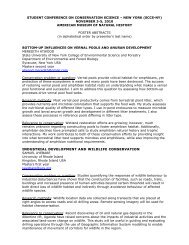The Search for life Are we Alone - American Museum of Natural ...
The Search for life Are we Alone - American Museum of Natural ...
The Search for life Are we Alone - American Museum of Natural ...
You also want an ePaper? Increase the reach of your titles
YUMPU automatically turns print PDFs into web optimized ePapers that Google loves.
are<strong>we</strong>alone<br />
the search <strong>for</strong> <strong>life</strong><br />
FROM THE HALL OF PLANET EARTH:<br />
THE LIVING PLANET – Life on Earth can exist as a result <strong>of</strong> a<br />
balance bet<strong>we</strong>en the following conditions.<br />
DISTANCE AND ENERGY<br />
Life needs energy, and the Earth has two sources: the heat <strong>of</strong><br />
the Sun and Earth’s own internal heat. <strong>The</strong> amount <strong>of</strong> energy<br />
received from the Sun is determined by the Sun’s brightness<br />
and Earth’s distance from the Sun. <strong>The</strong> internal heat <strong>of</strong> Earth<br />
comes mainly from the decay <strong>of</strong> radioactive elements.<br />
A PROTECTIVE SHIELD<br />
Only a portion <strong>of</strong> the Sun’s radiation reaches the surface <strong>of</strong> Earth.<br />
Charged particles and radiation harmful to <strong>life</strong> are deflected by<br />
Earth’s magnetic field and absorbed by the atmosphere.<br />
PROPER TEMPERATURE RANGE<br />
Earth’s average temperature is 15°C, with a range bet<strong>we</strong>en -50°C<br />
and 50°C. In contrast, the average temperature <strong>of</strong> its neighbor<br />
Venus is 482°C, and that <strong>of</strong> its other neighbor, Mars, is -63°C.<br />
Venus is warmer because it is closer to the Sun and is blanketed<br />
by a thick insulating atmosphere. Mars is colder because it is farther<br />
from the Sun and has almost no atmosphere.<br />
WATER<br />
<strong>The</strong> properties <strong>of</strong> water regulate Earth’s temperature. While water<br />
is freezing to <strong>for</strong>m ice, the water/ice system temperature cannot<br />
drop below the freezing point, 0°C. Likewise, while water is<br />
trans<strong>for</strong>ming to vapor, the temperature <strong>of</strong> the water/vapor system<br />
cannot go above boiling, or 100°C. This phenomenon exerts<br />
natural limits on the temperature range <strong>of</strong> Earth.<br />
THE RIGHT INGREDIENTS<br />
Our planet has abundant quantities <strong>of</strong> the six elements that<br />
comprise 95 percent <strong>of</strong> all living organisms: carbon, oxygen,<br />
hydrogen, sulfur, phosphorus, and nitrogen. <strong>The</strong>se elements,<br />
particularly carbon, are crucial <strong>for</strong> building cells and tissues and<br />
<strong>for</strong> the basic chemical processes <strong>of</strong> <strong>life</strong> as <strong>we</strong> know it.<br />
How would <strong>life</strong> on Earth be affected by the<br />
following changes:<br />
■ <strong>The</strong> Sun grew larger<br />
■ Earth’s atmosphere thinned<br />
■ Earth had no moon<br />
■ A greater number <strong>of</strong> large asteroids hit Earth<br />
Mercury<br />
Distance from the Sun:<br />
57,900,000 km<br />
Average temperature:<br />
204°C<br />
Earth<br />
Distance from the Sun:<br />
149,600,000 km<br />
Average temperature:<br />
15°C<br />
Jupiter<br />
Distance from the Sun:<br />
778,300,000 km<br />
Average temperature: -153°C<br />
Uranus<br />
Distance from the Sun:<br />
2,871,000,000 km<br />
Average temperature: -197°C<br />
SUN<br />
Venus<br />
Distance from the Sun:<br />
108,200,000 km<br />
Average temperature:<br />
482°C<br />
Mars<br />
Distance from the Sun:<br />
227,900,000 km<br />
Average temperature:<br />
-63°C<br />
Saturn<br />
Distance from the Sun:<br />
1,427,000,000 km<br />
Average temperature: -185°C<br />
Neptune<br />
Distance from the Sun:<br />
4,497,100,000 km<br />
Average temperature: -225°C<br />
© 2002 <strong>American</strong> <strong>Museum</strong> <strong>of</strong> <strong>Natural</strong> History.<br />
All Rights Reserved.
are<strong>we</strong>alone<br />
the search <strong>for</strong> <strong>life</strong><br />
FORMATION OF OUR<br />
SOLAR SYSTEM<br />
<strong>The</strong> Sun and the planets <strong>for</strong>med together, 4.6 billion years<br />
ago, from a cloud <strong>of</strong> gas and dust called the solar nebula.<br />
COLLAPSE AND ROTATION<br />
<strong>The</strong> slowly rotating solar nebula collapsed under its own gravity to <strong>for</strong>m<br />
a rapidly rotating disk, with the Sun at the center. Collisions <strong>of</strong> gas and<br />
dust within the disk concentrated the material into a thin plane.<br />
CONDENSATION<br />
<strong>The</strong> inner regions <strong>of</strong> the solar nebula <strong>we</strong>re hot, allowing only rocky<br />
material to condense. <strong>The</strong> rocky terrestrial planets <strong>for</strong>med there. Gases<br />
and ices condensed in the cooler outer regions, where the gas giant<br />
planets and their icy moons and comets <strong>for</strong>med.<br />
ACCRETION<br />
Small bodies collided, stuck together, and slowly built up the terrestrial<br />
planets. Such accretion also built up the cores <strong>of</strong> the gas giants until they<br />
<strong>we</strong>re massive enough <strong>for</strong> their gravity to capture the abundant gases.<br />
DIFFERENTIATION<br />
<strong>The</strong> terrestrial planets, as <strong>we</strong>ll as the larger moons and asteroids, have<br />
spherical layers that <strong>we</strong>re created by melting and differentiating.<br />
Heavier elements sank to the center, <strong>for</strong>ming iron-rich cores. Lighter<br />
materials <strong>we</strong>re buoyed upward to <strong>for</strong>m the outer rocky layers.<br />
Interactive kiosks on the ground floor <strong>of</strong> the Hall <strong>of</strong> the Universe<br />
further illustrate planet <strong>for</strong>mation.<br />
In the Hall <strong>of</strong> the Universe, on the lo<strong>we</strong>r level, is an<br />
Ecosphere. This enclosed spherical aquarium is a complete<br />
ecosystem.<br />
■<br />
■<br />
What <strong>life</strong> requirements discussed in the Space Show do<br />
you see present in the Ecosphere<br />
What is the energy source <strong>for</strong> this ecosystem<br />
© 2002 <strong>American</strong> <strong>Museum</strong> <strong>of</strong> <strong>Natural</strong> History. All Rights Reserved.

















